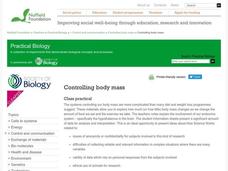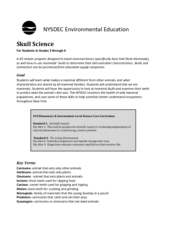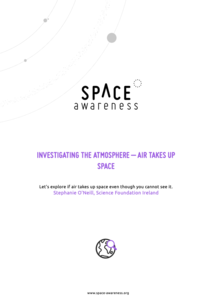ESL Kid Stuff
Directions: Left / Right / Forward / Back
Move to the left! Move to the right! Kids will definitely get moving with a instructional activity on directions. They review left, right, forward, and back before playing Pin the Tail on the Donkey and singing some songs about movement.
Virginia Department of Education
Sound
Add a little music to your next physics class. Pupils discuss how frequency determines pitch and take part in several activities designed to teach them more about sound, melody, resonance, and vibrations. They use materials to construct...
Virginia Department of Education
Building a DNA Model
It has been decades since the discovery of DNA. Still, activities such building this DNA model allow blossoming scientists to better understand the components that form this overall structure. During this activity, they will also...
Nuffield Foundation
Controlling Body Mass
Many variables impact your body mass, not just diet and exercise. Scholars collect and study data about body mass to better understand the complexity of a sensitive topic. They learn about leptin deficiency, the hypothalamus, and more.
Kenan Fellows
Analyzing Speed from Different Modalities
Show us your moves. Using sensor equipment, scholars track the motion of different movements, such as jogging, skipping, or jump roping. They analyze velocity and acceleration and create graphs representing each movement.
Brigham Young University
It's All in the Details
Designers communicate their vision for a set through a progression from thumbnail sketches, to drawings, to renderings. After examining a series of renderings, class members begin work on their own rendering paying particular attention...
Curated OER
The Roving Robotic Chemist
Junior oceanographers and underwater geologists describe the four major steps of mass spectrometry. They compete in small groups to simulate the tracking of a deepwater methane plume using imaginary autonomous underwater vehicles. Give...
Curated OER
Skull Science
What can your class learn from a skull? With proper facilitation, they can learn about diet, physical adaptations, special differences, and even the environment. Pupils will examine a series of mammal skulls and pelts to help them...
Curated OER
Roller Coasters
Twisting and turning through the sky, roller coasters are popular attractions at amusement parks around the world, but how exactly do they work? Explore the physics behind these thrilling rides with an engineering design activity....
University of Georgia
Bag O' Isotopes
Accommodate your chemistry class with an experiment that is both entertaining and educational. Through the activity, blossoming chemists perform calculations on various isotopes, as represented by beans and legumes, to obtain...
Teacher Vision
Political Events and Summer Olympic Games
During an Olympics year, the world joins together to celebrate athleticism, patriotism, and history. Learn about the Olympiads of the 20th century with a research project in which groups research one year's Olympic Games. They note the...
Bowland
Football, the Beautiful Game
Discover how to use mathematics to make a stronger soccer team. Young soccer enthusiasts use given data to make decisions about a soccer team. They decide which position to assign each player, consider what makes a good pass and...
Advocates for Youth
How Can I Take Care of My Health?
Life is all about choices, and a healthy life tends to involve a lot of healthy choices. Guide teenagers toward a life full of nutritious food, regular exercise, and responsible decisions with a series of lessons on healthy habits for...
Space Awareness
Investigating the Atmosphere - Air Takes Up Space
How do you know there is air? Can you see it, smell it, feel it? To begin the investigation, learners watch a video and discuss what they know about air and the atmosphere. Then, they participate in five different hands-on, inquiry-based...
National Museum of Mathematics
Hands-On Data Analysis
Jump at the chance to use this resource. A kinesthetic activity has classmates jumping in several different ways (standing, single-step, and multiple-step jumps) to create handprints on poster paper taped to the wall. They measure the...
Curated OER
Food Matters
Fifth graders identify physical and chemical changes. In this science inquiry lesson, 5th graders observe the changes that occur when making bread and butter. Students explain if the product is result of a physical or chemical change.
Other popular searches
- Adaptive Physical Education
- Physical Education Games
- Physical Education Warm Ups
- Physical Education Lessons
- "Physical Education" | Pe
- Physical Education Adhd
- Physical Education Athletics
- Physical Education & Health
- Physical Education Add
- Physical Education Pe
- Physical Education Added
- Physical Education Programs















